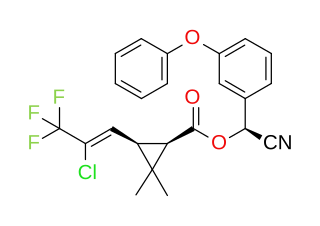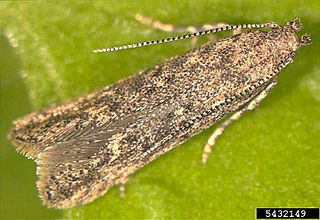Related Research Articles

Insecticides are substances used to kill insects. They include ovicides and larvicides used against insect eggs and larvae, respectively. Insecticides are used in agriculture, medicine, industry and by consumers. Insecticides are claimed to be a major factor behind the increase in the 20th-century's agricultural productivity. Nearly all insecticides have the potential to significantly alter ecosystems; many are toxic to humans and/or animals; some become concentrated as they spread along the food chain.

Pesticide resistance describes the decreased susceptibility of a pest population to a pesticide that was previously effective at controlling the pest. Pest species evolve pesticide resistance via natural selection: the most resistant specimens survive and pass on their acquired heritable changes traits to their offspring. If a pest has resistance then the pesticide lacks efficacy – efficacy and resistance are inversely related.

A pyrethroid is an organic compound similar to the natural pyrethrins, which are produced by the flowers of pyrethrums. Pyrethroids are used as commercial and household insecticides.

In organic chemistry, a carbamate is a category of organic compounds with the general formula R2NC(O)OR and structure >N−C(=O)−O−, which are formally derived from carbamic acid. The term includes organic compounds, formally obtained by replacing one or more of the hydrogen atoms by other organic functional groups; as well as salts with the carbamate anion H2NCOO−.
Ryanodine receptors form a class of intracellular calcium channels in various forms of excitable animal tissue like muscles and neurons. There are three major isoforms of the ryanodine receptor, which are found in different tissues and participate in different signaling pathways involving calcium release from intracellular organelles. The RYR2 ryanodine receptor isoform is the major cellular mediator of calcium-induced calcium release (CICR) in animal cells.
Chloropicrin, also known as PS and nitrochloroform, is a chemical compound currently used as a broad-spectrum antimicrobial, fungicide, herbicide, insecticide, and nematicide. It was used as a poison gas in World War I. Its chemical structural formula is Cl3CNO2.

Ryanodine is a poisonous diterpenoid found in the South American plant Ryania speciosa (Salicaceae). It was originally used as an insecticide.

Spinosad is an insecticide based on chemical compounds found in the bacterial species Saccharopolyspora spinosa. The genus Saccharopolyspora was discovered in 1985 in isolates from crushed sugarcane. The bacteria produce yellowish-pink aerial hyphae, with bead-like chains of spores enclosed in a characteristic hairy sheath. This genus is defined as aerobic, Gram-positive, nonacid-fast actinomycetes with fragmenting substrate mycelium. S. spinosa was isolated from soil collected inside a nonoperational sugar mill rum still in the Virgin Islands. Spinosad is a mixture of chemical compounds in the spinosyn family that has a generalized structure consisting of a unique tetracyclic ring system attached to an amino sugar (D-forosamine) and a neutral sugar (tri-Ο-methyl-L-rhamnose). Spinosad is relatively nonpolar and not easily dissolved in water.

Cyhalothrin is the ISO common name for an organic compound that, in specific isomeric forms, is used as a pesticide. It is a pyrethroid, a class of synthetic insecticides that mimic the structure and properties of the naturally occurring insecticide pyrethrin which is present in the flowers of Chrysanthemum cinerariifolium. Pyrethroids such as cyhalothrin are often preferred as an active ingredient in agricultural insecticides because they are more cost-effective and longer acting than natural pyrethrins. λ-and γ-cyhalothrin are now used to control insects and spider mites in crops including cotton, cereals, potatoes and vegetables.
Sodium channel blockers are drugs which impair the conduction of sodium ions (Na+) through sodium channels.

Cyfluthrin is a pyrethroid insecticide and common household pesticide. It is a complex organic compound and the commercial product is sold as a mixture of isomers. Like most pyrethroids, it is highly toxic to fish and invertebrates, but it is far less toxic to humans. It is generally supplied as a 10–25% liquid concentrate for commercial use and is diluted prior to spraying onto agricultural crops and outbuildings.

Tuta absoluta is a species of moth in family Gelechiidae known by the common names South American tomato pinworm, tomato leafminer, tomato pinworm and South American tomato moth. It is well known as a serious pest of tomato crops in Europe, Africa, western Asia and South and Central America, with larvae causing up to 100% loss if not effectively controlled.

Tefluthrin is the ISO common name for an organic compound that is used as a pesticide. It is a pyrethroid, a class of synthetic insecticides that mimic the structure and properties of the naturally occurring insecticide pyrethrin which is present in the flowers of Chrysanthemum cinerariifolium. Pyrethroids such as tefluthrin are often preferred as active ingredients in agricultural insecticides because they are more cost-effective and longer acting than natural pyrethrins. It is effective against soil pests because it can move as a vapour without irreversibly binding to soil particles: in this respect it differs from most other pyrethroids.

Sulfoxaflor, also marketed as Isoclast, is a systemic insecticide that acts as an insect neurotoxin. A pyridine and a trifluoromethyl compound, it is a member of a class of chemicals called sulfoximines, which act on the central nervous system of insects.

Cyantraniliprole is an insecticide of the ryanoid class, specifically a diamide insecticide. It is approved for use in the United States, Canada, China, and India. Because of its uncommon mechanism of action as a ryanoid, it has activity against pests such as Diaphorina citri that have developed resistance to other classes of insecticides. Cyantraniliprole is highly toxic to bees, which resulted in registration of its use as a pesticide being delayed in the USA.
The Insecticide Resistance Action Committee (IRAC) was formed in 1984 and works as a specialist technical group of the industry association CropLife to be able to provide a coordinated industry response to prevent or delay the development of insecticide resistance in insect and mite pests. IRAC strives to facilitate communication and education on insecticide and traits resistance as well as to promote the development and facilitate the implementation of insecticide resistance management strategies.
Ryania is a genus of flowering plants in the family Salicaceae; it was previously listed in the now defunct family Flacourtiaceae.

Chlorantraniliprole (Rynaxypyr) is an insecticide of the ryanoid classes. Chlorantraniliprole was developed world-wide by DuPont and belongs to a class of selective insecticides featuring a novel mode of action to control a range of pests belonging to the order Lepidoptera (moth) and some other Coleoptera (beetle), Diptera (fly), and Isoptera (termite) species.

Broflanilide is a complex, polycyclic, organohalogen insecticide which provides a novel mode of action (MoA).

Flupyradifurone is an organic heterocyclic compound. It is used as a novel butenolide insecticide. Flupyradifurone shows efficient protection to crops and is much safer for non-target organisms compared to other commercial insecticides. Flupyradifurone was developed by Bayer CropScience under the name Sivanto. Sivanto was launched in 2014 since it obtained its first commercial registration in central America. Insecticide Resistance Action Committee (IRAC) classified Flupyradifurone as 4D subset (butenolide) and it is the first pesticide in the butenolide category. In 2015, it was approved by EU.
References
- ↑ Usherwood, P.N.R.; Vais, H. (1995). "Towards the development of ryanoid insecticides with low mammalian toxicity". Toxicology Letters . 82–83: 247–54. doi:10.1016/0378-4274(95)03558-3. PMID 8597061.
- ↑ Teixeira, Luís A; Andaloro, John T (2013). "Diamide insecticides: Global efforts to address insect resistance stewardship challenges". Pesticide Biochemistry and Physiology. 106 (3): 76–78. doi:10.1016/j.pestbp.2013.01.010.
- 1 2 IRAC International MoA Working Group (March 2020). "IRAC Mode of Action Classification Scheme Version 9.4". Insecticide Resistance Action Committee.